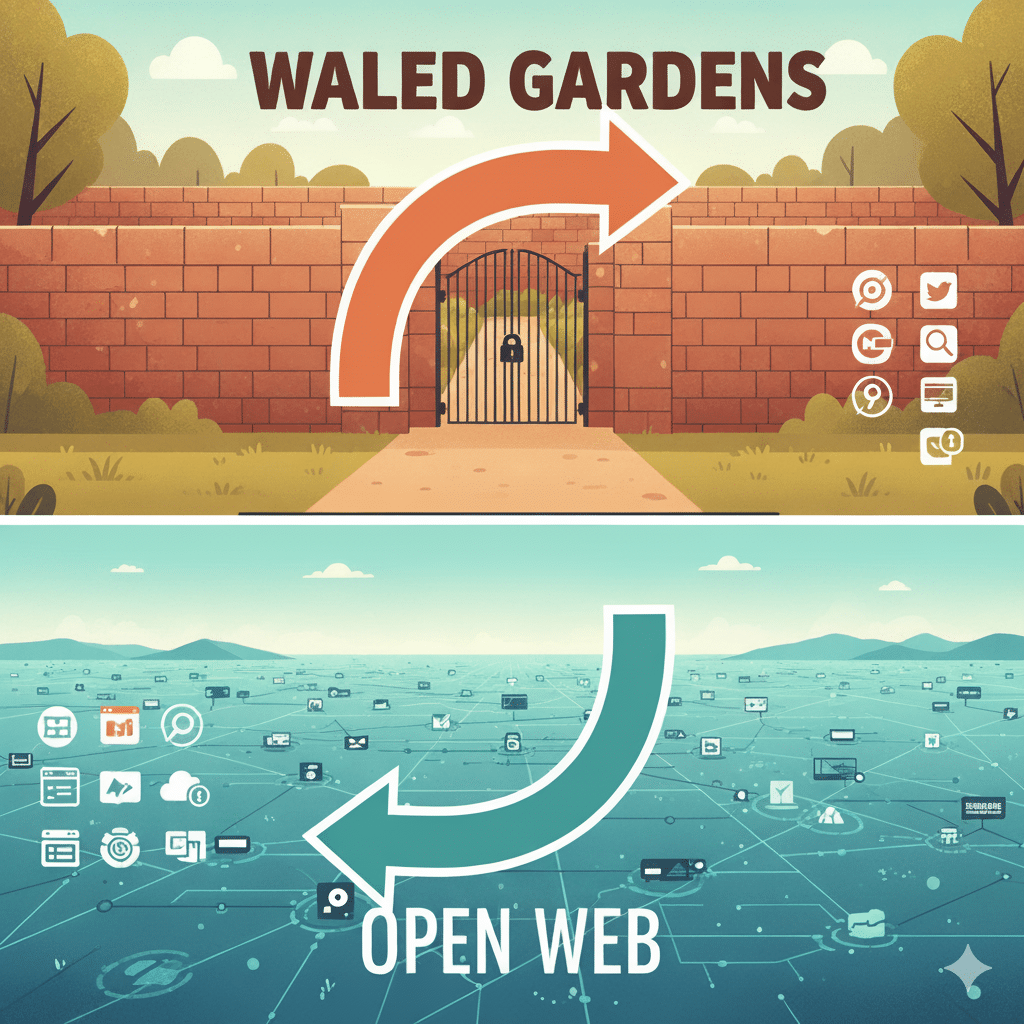Should you double down on Facebook and Google, or explore the open web? It’s the question almost every performance marketer has asked themself at some point.
Walled gardens like Meta and Google have become familiar playgrounds for advertisers, thanks to their predictable, controlled, and often effective environments. But, beyond those walls lies the vast, seemingly chaotic, but opportunity-filled territory of the open web. For many marketers, that frontier can feel intimidating. Walled gardens promise convenience, while the open web offers possibility, but also complexity: How do you weigh them against each other?
The truth is, though, that the open web isn’t the wild west we sometimes think it is — it’s a strategic landscape that, when understood, can deliver returns that walled gardens simply can’t match. To help make sense of this landscape, we turned to Nadim Kuttab, CEO and co-founder of Xevio, who uses the perfect analogy to describe the differences between these two worlds — one that transforms how advertisers can think about investment strategy.
The Walled Gardens: A Predictable, Controlled Mall
Nadim likens walled gardens like Meta and Google to a mall. Picture walking through a closed space with a limited set of stores — a couple coffee shops, a handful of clothing outlets, some restaurants. Everything is tidy, structured, and controlled to a select number of stores, or placements.
The mall analogy works well to describe the environment of a walled garden. These platforms provide a finite amount of ad inventory across their properties. Targeting is straightforward, placement options are standardized, and the environment feels familiar.
In turn, this offers important benefits to advertisers. Predictable targeting, for instance on Meta, allows advertisers to segment audiences into granular buckets by demographics, interests, and behavior. The controlled environment means that campaigns are run within an ecosystem where placements and outcomes are easier to model. The ease of optimization that comes with a walled garden is also a significant benefit, as algorithms provide quick feedback loops that make it easy to adjust bid strategies or creative.
The “mall” does have drawbacks, though. Limited inventory means that advertisers only have a select number of “stores” to choose from. Once the audience is saturated, diminished returns are possible. There’s also a higher degree of competition when everyone else is also vying for the same limited number of placements, driving up costs. It’s important to remember, too, that these types of environments are controlled by their platforms, meaning there are fewer options for differentiating beyond standard ad formats.
Despite their limitations, it’s easy to understand why walled gardens have become the default option for many advertisers. For those newer to performance marketing, this plug-and-play option means that campaigns can be launched quickly, with reliable measurement tools.
These walled gardens are also deeply embedded in the customer journey. Google Search still plays a pivotal role in capturing high-intent queries, while Meta remains a cultural hub through Instagram and Facebook, places where users spend a large amount of time. For objectives like brand awareness, reach, or direct-response, walled gardens still provide unmatched efficiency.
However, advertisers who over-rely on these environments can quickly hit a ceiling. As Nadim points out, true profitability is rarely uncovered when you’re competing in the same crowded place as everyone else.
The Open Web: A Vast and Strategic “Bazaar”
By contrast, Nadim describes the open web as a “bazaar,” with a neverending stretch of stalls filled with everything from large, mainstream publishers like Yahoo or CNN, to small niche blogs and news sites. Where the mall limits your placement options, the bazaar offers infinite opportunity.
There’s scale in the abundance that a bazaar environment provides, with billions of possible impressions across millions of sites. Some stalls are large, polished, and bustling; others are small and with less traffic, but a loyal audience. The key difference here, though, is choice: In the bazaar, you don’t have to buy from every stall. You can be much more selective, curating your own placements that align with your audience and goals.
For performance advertisers, the open web’s large reach means that you can reach hundreds of millions of unique users that walled gardens simply can’t cover. Ads can run alongside a wide range of content, from breaking news to lifestyle tips. These placement-level strategy opportunities are enticing to advertisers who can whitelist high-performing sites, blacklist underperforming ones, and optimize with granular data.
Ads can often feel disruptive in walled gardens, but on the open web, they can be highly contextual and feel less out of place. A financial services ad running beside a personal finance article on a news site, e.g., is relevant in a way that doesn’t feel forced or unnatural.
Studies suggest that ads placed in trusted environments often drive higher attention and brand recall than those in social feeds. Not only does this make the open web a good choice for performance campaigns, then, but also for brand-building efforts.
ROI Optimization Strategy on the Open Web
Choice is powerful, but it requires strategy. To maximize profitability on the open web, advertisers must go beyond audience targeting and focus on placement-specific performance. Nadim recommends several key tactics:
Whitelisting and Blacklisting
By analyzing campaign data, advertisers can identify which publishers, domains, or placements drive the highest ROAS. Building whitelists of these top performers means that more budget flows to quality traffic, while blacklists cut wasted spend on the least effective placements.
This approach is particularly important when testing at scale: Without filters in place, budget may be passed toward low-quality sites that generate clicks, but not conversions. With careful placement management, advertisers can turn their cluttered bazaar into a curated marketplace with high-value stalls.
First-Click vs. Last-Click Impact
Realize’s data shows that first-click performance on the open web can generate three to four times more sales than last-click attribution alone. Without tracking first-click contributions, advertisers run the risk of underestimating ROI and undervaluing your campaigns.
For instance, a user might discover a skincare brand via a Realize-powered content site, click through, then leave. A week later, they convert via a Google Search ad. If you only credit the last click, Google appears responsible, but the true catalyst was their first interaction.
Lifetime ROAS (LTV-Based Optimization)
Short term CPA targets are useful for daily adjustments, but long-term success heavily depends on lifetime value. Looking at 30-, 60-, 90-, or even 180-day profitability reveals the true impact of open web campaigns. Feeding this data back into Realize’s algorithm helps you scale with confidence.
This is especially the case with verticals like subscription services, where profitability may not be apparent until month three or four. By only measuring ROAS, advertisers may undervalue important placements that deliver loyal, high-value customers.
AI-Powered Optimization
With platforms like Realize, AI-driven optimization accelerates performance, thanks to automatically adjusting bids, placement updates, and budget optimization based on granular signals. This leaves performance marketers free to focus on strategy, rather than manual campaign tweaks. AI is one of the best ways to accelerate creative testing, too, looking at the best performing headlines, images, and CTAs faster than manual experimentation. In a landscape as vast as the open web, this speed is critical for maintaining campaign efficiency.
Intraday Scaling
One unconventional tactic that Nadim highlights is intraday scaling. This is where budgets are aggressively increased during historically strong performance windows, such as weekends or paydays. Advertisers can multiply daily spend by 5-10x, unlocking profitable scale while maintaining overall campaign effectiveness. This is only possible on the open web, where the large quantity of inventory supports sudden bursts of spend, without oversaturing a limited audience.
The Tradeoffs: Open Web vs. Walled Gardens
Ultimately, the choice between investing in a walled garden or the open web isn’t binary, coming with tradeoffs that performance marketers must understand. While there’s control and predictability with walled gardens, they limit how and where ads appear. The open web offers greater flexibility and scale, but requires more active management. The walled garden can also feel easier, which is enticing for performance marketers stretched thin. Open web placements require more strategic thinking when it comes to placement analysis, LTV modeling, and creative iteration, but can pay off for those putting in that strategic work.
For performance marketers, the most profitable approach is rarely all or nothing: Instead, it’s about diversifying strategy and your investment — use walled gardens for predictable scale, while leveraging the open web for strategic growth and long-term profitability.
Diversification also provides a buffer in a world of increasing privacy regulations and algorithmic changes that can plague walled garden platforms. Over-reliance on a single platform can put your revenue at risk, but by spreading spend across both environments, advertisers can somewhat insulate themselves from sudden shifts, while still benefiting from platforms that offer more incremental growth.
Key Takeaways
The landscape of advertising is no longer confined to a handful of players, with the open web offering vast and diverse choice. True profitability requires looking beyond ROAS and measuring lifetime value, first-click impact, and the spillover effects of all types of performance campaigns. Tools like Realize make navigating the bazaar of the open web easier, automating optimizations while allowing advertisers to focus on strategy.
With the advertising world at an inflection point, where open web is beginning to look more enticing due to the limits of walled gardens, it’s a strategic advantage if advertisers understand how to harness the power of both environments. As Nadim’s insights suggest, success lies in shifting perspective, treating the open web like a bazaar of opportunity rather than a chaotic risk. For advertisers willing to embrace this choice, measure impact holistically, and optimize campaigns strategically, the ROI potential is immense.
Frequently Asked Questions (FAQs)
What are some examples of open web platforms?
Major publishers like CNN, Yahoo, MSN, and niche blogs or news outlets all fall under the umbrella of potential open web placements.
How can I track ROI across so many different open web placements?
Using attribution tools and Taboola’s analytics to measure first and last click impact, as well as lifetime ROAS, is one of the best ways to keep track of all the data accumulated by your campaigns.
Is the inventory on the open web as high quality as walled gardens?
Yes, premium publishers provide trusted environments, and with whitelisting/blacklisting, you can easily ensure that your campaigns focus on the highest quality placements.
What’s the best way to start testing the open web?
Begin small with a diversified set of placements, track performance closely, and then scale into the publishers that deliver the best long-term ROI.



